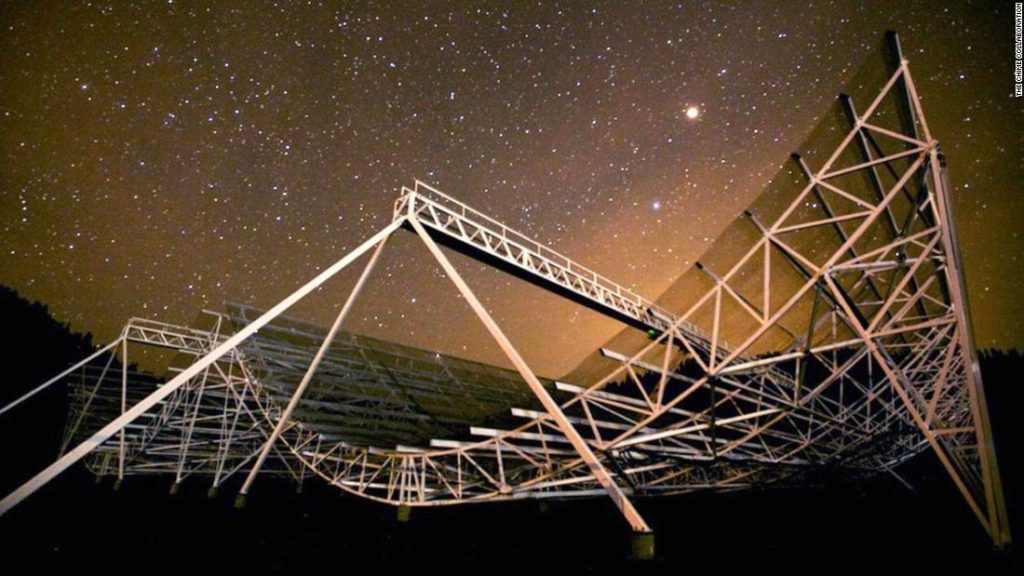
Fast radio bursts, or FRBs, are intense bursts of radio waves up to milliseconds long from unknown sources. The first FRB was discovered in 2007, and since then, hundreds of these cosmic flashes have been detected coming from different and faraway points across the universe.
Many FRBs emit ultra-bright radio waves that last only a few milliseconds at most before disappearing completely, and about 10% of these are known to repeat and have patterns.
This telescope, which has been in operation since 2018, is constantly watching the sky, and in addition to fast radio bursts, it is sensitive to radio waves emitted by hydrogen far in the universe.
Astronomers who used CHIME discovered something on December 21, 2019, that immediately caught their attention: a fast radio burst that was “in many ways strange,” according to Danielle Mitchell, a postdoctoral researcher. at the Kavli Institute for Astrophysics and Space Research at the Massachusetts Institute of Technology.
The signal, called FRB 20191221A, lasted up to three seconds — about 1,000 times longer than typical fast radio bursts.
Michelli was monitoring the data as received from CHIME, when the explosion occurred. The signal is the longest lasting fast radio wave to date.
“It was extraordinary,” Mitchell said. “It wasn’t very long, and lasted about three seconds, but there were periodic peaks that were remarkably accurate, with every millisecond—boom, boom, boom—emitting like a heartbeat. This is the first time the same signal has been periodic.” “
While FRB 20191221A has yet to replicate, “the signal is formed by a series of successive peaks that we found separated by about 0.2 seconds,” he said in an email.
unknown source
Micheli said the research team does not know the exact galaxy from which the explosion originated, and even the estimate of the distance to one billion light-years is “highly uncertain”. While CHIME is primed to search for batches of radio waves, they are not very good at pinpointing their points of origin.
However, CHIME is being developed through a project where additional telescopes, currently under construction, will monitor together and be able to triangulate radio bursts to specific galaxies, he said.
But the signal contains clues about where it came from and what might have caused it.
“CHIME has now detected many FRBs with different characteristics,” said Micheli. “We have seen some live inside highly turbulent clouds, while others appear to be in clean environments. From the characteristics of this new signal, we can say that around this source, there is a cloud of plasma that must be very turbulent.”
When the researchers analyzed FRB 20191221A, the signal was similar to emissions from two different types of neutron stars, or the dense remains after the death of a giant star, called radio and magnetic pulsars.
Magnetars are neutron stars with incredibly strong magnetic fields, while radio pulsars emit radio waves that appear to pulsate as the neutron star spins. Both stellar objects create a signal similar to the beam flashing from a lighthouse.
The rapid radio burst appears to be a million times brighter than these emissions. “We think this new signal could be a magnetar or a pulsar on doping,” Micheli said.
The research team will continue to use CHIME to monitor the sky to get more signals from this radio burst, as well as others with a similar periodic signal. The frequency of radio waves and how they change can be used to help astronomers learn more about the rate at which the universe is expanding.
“This discovery raises the question of what could be causing this extreme signal that we haven’t seen before, and how we can use this signal to study the universe,” Micheli said. “Future telescopes promise to detect thousands of FRBs per month, at which point we may find more of these periodic signals.”

“Avid problem solver. Extreme social media junkie. Beer buff. Coffee guru. Internet geek. Travel ninja.”





More Stories
A definitive end to AdBlock on YouTube – Google is preparing for tougher measures
By 2030, 5.25-inch floppy disks are expected to continue to be used on San Francisco trains
The voice of Zeta Macripolia with player Rock Zook